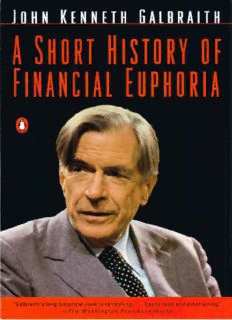
Galbraith - A Short History of Financial Euphor.. PDF
Preview Galbraith - A Short History of Financial Euphor..
PENGUIN BOOKS ASHORTHISTORY OF FINANCIAL EUPHORIA John Kenneth Galbraith is the Paul M. Warburg Professor of Economics Emeritus at Harvard Uni versity and was the u.S. ambassador to India during the Kennedy administration. His works The Great Crash 1929, The Affluent Society, The New Indus trial State, and Economics and the Public Purpose are landmarks ofpolitical and economic analysis. A S H 0 R T o HISTORY F FINANCIAL EUPHORIA John Kenneth Galbraith WHITTLE BOOKS IN ASSOCIATION WITH PENGUIN BOOKS PENGUINBOOKS PublishedbythePenguinGroup PenguinGroup(USA)Inc.,375HudsonStreet,NewYork,NewYork10014,U.S.A. PenguinGroup(Canada),90EglintonAvenueEast,Suite700,Toronto, Ontario,CanadaM4P2Y3(adivisionofPearsonPenguinCanadaInc.) PenguinBooksLtd,80Strand,LondonWC2RORL,England PenguinIreland,25StStephen'sGreen,Dublin2,Ireland(adivisionofPenguinBooksLtd) PenguinGroup(Australia),250CamberwellRoad,Camberwell, Victoria3124,Australia'(adivisionofPearsonAustraliaGroupPtyLtd) PenguinBooksIndiaPvtLtd,11CommunityCentre,PanchsheelPark,NewDelhi- 110017,India PenguinGroup(NZ),cnrAirborneandRosedaleRoads, Albany,Auckland1310,NewZealand(adivisionofPearsonNewZealandLtd) PenguinBooks(SouthAfrica)(Pty)Ltd,24SturdeeAvenue, Rosebank,Johannesburg2196,SouthAfrica PenguinBooksLtd,RegisteredOffices:80Strand,LondonWC2RORL,England PublishedintheUnitedStatesofAmericaby VikingPenguin,adivisionofPenguinBooksUSAInc.,1993 PublishedinPenguinBooks1994 19 20 18 Copyright©JohnKennethGalbraith,1990 Allrightsreserved ThisbookwasfirstpublishedbyWhittleBooksaspartoftheLargerAgendaSeries. ReprintedbyarrangementwithWhittleCommunicationsL.P. Photographs: Paul M. Warburg, Brown Brothers, page 6; Roger Babson, Culver Pictures, page8;railroadconstruction,courtesyofUnionPacificMuseumCollection,page65;Joseph Schumpeter,theBettmannArchive,page67;J.P.Morgan,CulverPictures,page68;Charles Ponzi,BrownBrothers,page73;Floridalandboom,FloridaStateArchives,page74;Charles Mitchell, Brown Brothers,page 76;IrvingFisher, CulverPictures,page79; 1929crash, the Bettmann Archive, page 82; Bernard Cornfeld, © Michael Creccorrhe Picture Group, page 90;RobertVesco,APlWideWorldPhotos,page93; 1987crash,©SusanMeise1as/Magnum Photos,page96;RobertCampeau,theBettmannArchive,page103. Illustrations:Hollandtulips,courtesyofW.GrahamAraderIII,Chicago,page29;JohnLaw, CulverPictures,page35;RobertHarley,CulverPictures,page44;SouthSeaCompanyterri tory map, courtesy ofthe Newberry Library, Chicago, page 46; SirWilliam Phips, Culver Pictures,page55. THE LIBRARY OFCONGRESS HAS CATALOGUEDTHE HARDCOVER AS FOLLOWS: Galbraith,JohnKenneth. Ashorthistoryoffinancialeuphoria/JohnKennethGalbraith. p. em. Includesbibliographicalreferences. ISBN0-670-85028-4(he.) ISBN01402.38565(pbk.) 1.Speculation-Casestudies. I.Title. HG4528.G35 1993 332.64'5-dc20 92-50765 PrintedintheUnitedStatesofAmerica SetinSabon DesignedbyKathrynParise ExceptintheUnitedStatesofAmerica,thisbookissoldsubjecttotheconditionthatitshall not,bywayoftradeorotherwise,belent,re-sold,hiredout,orotherwisecirculatedwithout the publisher's priorconsentinany form ofbindingorcoverotherthan thatinwhich itis published and without a similar condition including this condition being imposed on the subsequentpurchaser. c o s N T E N T Foreword to the 1993 Edition VII 1 The SpeculativeEpisode 1 2 The Common Denominators 12 3 The Classic Cases, I: The Tulipomania;John Law and the Banque Royale 26 4 The Classic Cases, II: The Bubble 43 5 TheAmericanTradition 53 6 1929 70 7 October Redux 87 8 Reprise 105 Notes on Sources 111 v F o R E w o R D TO THE 1993 EDITION Itis nowthreeyears sinceIdid the main work on this small book. As I told in the Foreword to the earlier edition, it concerns matters that have interested me for a third ofa centuryand more. I first dealt with them in The Great Crash, 1929, published a little after the twen ty-fifth anniversary ofthe 1929 debacle. That book has been continuously available ever since. Whenever it was about to pass out of print, some new speculative episode or disaster would bring it back to public atten tion. Over a lifetime I have been, in a modest way, a steady beneficiary of the speculative aberration in its association with more than occasional insanity. Only a stalwart charac- ter keeps me from welcoming these events vii dohn Kenneth Galbraith as proof of personal prescience and as a source ofsmall financial reward. In the first Foreword to this volume,I told of my hope that business executives, the in habitants of the financial world and the citi zens of speculative mood, tendency or temptation might be reminded ofthe waythat not only fools but quite a lot of other people are recurrently separated from their money in the moment ofspeculative euphoria. I am less certain than when I then wrote of the social and personal value of such a warning. Recurrent speculative insanity and the associ ated financial deprivation and larger devasta tion are, I am persuaded, inherent in the system. Perhaps it is better that this be recog nized and accepted. I n the years since I wrote this short disquisi tion, the main players in the most recent speculative episode, that of the extravagant eighties, have met their all but inevitable fate, and the larger economic consequences have been made stronglyand sadlyevident. The list v IIi of those who have descended abruptly from A Short History of Financial Euphoria the heights is long, and only a few need be mentioned. Mr. Michael Milken, perhaps the most spectacular figure of the last boom and certainlythe bestpaid, is a recentresident in a minimum-security gaol, which, if not wholly uncomfortable, could not have seemed per sonally rewarding. One supposes that he met each new day without enthusiasm. Mr. Donald Trump is said not to be broke; he was, however, described in recent news ac counts as having a negative net worth. These distinctions are no doubt important in the world of finance. The Reichman brothers, with Robert Campeau the Canadiangiftto fi nancial excess, are indubitably broke with de pressive effect on the banks that were captured bytheireuphoric mood. Perhaps itis to their credit that, like Donald Trump, they erected monuments that will long commemo rate their adventure. In London, tourists go ing down the Thames to the Tower will extend their journeyto encompass the Canary Wharf development, perhaps the most awe some recent example ofspeculative dementia. To a marked extent, the speculative orgy of the eighties was in real estate, including that financed through the S & L's by the guaran- teeing American taxpayer. Salomon Brothers i x
Description: